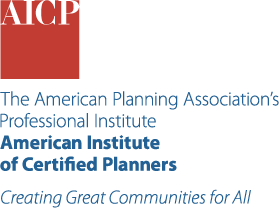Looking for education on this topic?
Check Out Our Passport Courses
Passport is your ticket to the training, experiences, and connections that will take you where you want to go in your planning career. Subscribe for unlimited access for one year to APA's extensive learning library of solution-oriented content facilitated by planners, for planners.
-
Walking the Walk: How Walkability Raises Home Values in U.S. Cities
August 2009by: Joseph CortrightThis report uses Walk Scores to measure the impact of walkability on home values. -
Los Angeles, CA, Municipal Code
Updated June 2022This city's municipal code belongs in the Biophilic Planning and Integrated Water Resource Management collections. -
The Safe Drinking Water Act
42 US Code §300f, Adopted 1974by: United States Environmental Protection AgencyThe Safe Drinking Water Act (SDWA) protects public drinking water supplies throughout the nation to ensure the safety of public health. It authorizes EPA to set standards regarding water quality protection, wastewater management, water supply, and nationwide wellhead protection programs. -
Land Use and Driving: The Role Compact Development Can Play in Reducing Greenhouse Gas Emissions
2010by: Uwe Brandes, Rachel MacCleery, Sarah Jo PetersonThis report summarizes the results of three independent studies that discuss the effects of compact development on greenhouse gas emissions. -
Response to Putting People First: An Alternative Perspective with an Evaluation of the NCE Cities "Trillion Dollar" Report
December 2015by: Todd LitmanThis report responds to Wendell Cox’s Putting People First: An Alternative Perspective with an Evaluation of the NCE Cities “Trillion Dollar” Report – itself a response to the author’s Analysis of Public Policies that Unintentionally Encourage and Subsidize Urban Sprawl. -
Selling Smart Growth: Communicating the Direct Benefits of More Accessible, Multi-Modal Locations to Households, Businesses and Governments
March 2019by: Todd LitmanThis report discusses the benefits of smart growth and shares how to communicate these benefits to residents, developers, and policy makers. -
Smart Growth and Economic Success: Strategies for Local Governments
EPA 231-R-14-011, March 2014by: Melissa Kramer, Lee SobelThis report argues that local governments should use smart growth as a strategy to cope with growing infrastructure costs and shrinking revenue. -
Smart Growth and Economic Success: The Business Case
November 2013by: Melissa Kramer, Lee SobelThis report lays out the business case for smart growth, including increased productivity and innovation, improved ability to compete for labor, and stronger retail sales. -
Evaluating Transportation Land Use Impacts: Considering the Impacts, Benefits and Costs of Different Land Use Development Patterns
March 2019by: Todd LitmanThis report highlights how transportation interventions have led to either sprawl or smart growth. -
Promoting Public Health Through Smart Growth
2005by: Lawrence Frank, Sarah Kavage, Todd LitmanThis report shares how the built environment influences transportation choices, which influences public health. -
Land Use and Traffic Congestion
Final Report 618, March 2012by: J. Richard KuzmyakThis report examines the relationship between high density development and traffic congestion using data from Phoenix, Arizona. -
Evaluating Criticism of Smart Growth
November 2018by: Todd LitmanThis report critiques the most common criticisms of smart growth. -
Land Use and Vehicle Miles of Travel in the Climate Change Debate: Getting Smarter Than Your Average Bear
Proceedings of the 2010 Land Policy Conference, 2011by: Marlon Boarnet, Douglas Houston, Gavin FergusonThis article concludes that employment accessibility would be a more effective land-use policy for reducing VMT than neighborhood population density, especially in the Los Angeles area. -
Assessing Benefits of Neighborhood Walkability to Single-Family Property Values: A Spatial Hedonic Study in Austin, Texas
Journal of Planning Education and Research, 35(4): 471-488, 2015by: Wei Li, Kenneth Joh, AICP, Chanam LeeThis article measures the impact of walkability on single-family property values in Austin, Texas. -
Inclusively Walkable: Exploring the Equity of Walkable Housing in the San Francisco Bay Area
The International Journal of Justice and Sustainability, 5: 527-554, 2016by: William Riggs, AICPThis article reports that black residents of the San Francisco Bay Area are less likely to live in walkable areas. -
Growing Cities Sustainably: Does Urban Form Really Matter?
Journal of the American Planning Association 78(2): 121-137, 2012by: Marcial Echenigue, Anthony Hargreaves, Gordon MitchellThis JAPA article uses forecasting and modeling to show that compact development is not clearly more sustainable than sprawl. -
Grappling with Smart City Politics in an Era of Market Triumphalism
Urban Studies, 50(11): 2151-2157, 2013by: David Gibbs, Rob Krueger, Gordon MacleodThis article introduces a special issue of Urban Studies on the topic of the economic, social, and environmental dimensions of smart growth. -
Determining Optimal Urban Expansion, Population and Vehicle Density, and Housing Types for Rapidly Growing Cities
Proceedings of the World Conference on Transport Research, Shanghai, China, July 10–15, 2016by: Todd LitmanThis article sets optimal density and vehicle ownership rates for constrained and unconstrained cities and advocates for the use of smart growth and Transportation Demand Management (TDM) policies. -
Does Compact Development Make People Drive Less?
Journal of the American Planning Association, 83(1): 7-18, 2017by: Mark StevensThis JAPA article discusses the impact that compact development has on driving patterns, given the mixed results in current research. -
Danger Zone: Land Use and the Geography of Neighborhood Crime
Journal of Urban Economics, 100: 104-119, 2017by: Tate TwinamThis article studies the effect that residential density and mixed land use has on crime in Chicago. -
Can Smart Growth Policies Conserve Energy and Reduce Emissions?
Center for Real Estate Quarterly Journal, 5(2): 1-11, 2011by: Todd LitmanThis article discusses the energy conservation and emissions reductions associated with smart growth policies. -
IMLA Model Sign Code—6th Rough Draft
May 2019This draft model sign code acknowledges the U.S. Supreme Court’s decision in Reed v. Town of Gilbert and provides a template to help cities and counties draft content-neutral sign regulations. -
Hazard Mitigation Planning for Local Communities
March 2021This fact sheet describes the local hazard mitigation planning process in accordance with federal law and regulations. -
Short Term Rentals
2021 Legislative Issue Briefs, revised December 1, 2020by: Casey CookThis briefing paper argues for legislation restoring local zoning authority over short-term rental properties in Florida cities. -
The Secretary of the Interior’s Preservation Planning Standards and Guidelines
September 1983This guide shares three standards for preservation planning and specific guidelines for each. -
Smart Climate Action Through Transfer of Development Rights
2021by: Richard Pruetz, FAICPThis book explores how local jurisdictions can use transferable development rights (TDR) to mitigate and adapt to climate change. -
Olympia, WA, Rain Garden Incentive Program
April 2019This web page describes an incentive program that reimburses applicants up to $400 for the completion of a rain garden in an existing development. -
Free Speech Law for On Premise Signs
Third Edition 2020by: Daniel MandelkerThis guide provides a comprehensive overview of the case law affecting the substantive provisions and administration of local sign regulations. -
Fort Bend County, TX, Orders for Regulation of Outdoor Lighting in the Unincorporated Areas of Fort Bend County, Texas
Adopted 2004, updated August 29, 2006The county’s outdoor lighting regulations were adopted in 2004 and amended in 2006. -
Assessing a Set of Indicators for Creative Placemaking: Reflections from the Field
Community Development Investment Review, Volume 10, Issue 2, December 2014by: Elaine Morley, Mary WinklerThis article explores the challenges related to identifying effective indicators for creative placemaking projects. -
Austin, TX, 2014 Bicycle Master Plan
Adopted November 2014This comprehensive plan element is a supplement to the 2012 Imagine Austin comprehensive plan and applies leading-edge thought to facilities across the entire network. -
Built for Health: Biophilia
January 2018This podcast discusses the psychological, physiological, and environmental effects of biophilic design. -
Barriers to Building Wildlife-Inclusive Cities: Insights from the Deliberations of Urban Ecologists, Urban Planners and Landscape Designers
People and Nature, 4(1):62-70, 2021by: Cria Kay, Adam Rohnke, Heather SandarThis article discusses the importance of collaboration across disciplines to have successful planning for urban wildlife. -
Biophilic Design and Climate Change: Performance Parameters for Health
Frontiers in Built Environment, 5, 2019by: Julia Africa, Judith Heerwagen, Vivian LoftnessThis article demonstrates how biophilic design principals can provide resilience in human health and in the built environment. -
Emerging Biophilic Urbanism: The Value of the Human–Nature Relationship in the Urban Space
Sustainability, 12(13), 2020by: Simona TotafortiThis article presents research that suggests that biophilic planning can be useful for adapting to future challenges by enhancing the human-nature connection. -
Biophilic Laws: Planning for Cities with Nature
Virginia Environmental Law Journal,34,2016by: James BrownThis article highlights legal policy used to increase nature in cities across North America. -
Biophilic Cities Lead the Way to Urban Sustainability
The Dirt, June 2016by: Jared GreenThis article presents examples of biophilic planning programs in several cities. -
Urban Green Space, Public Health, and Environmental Justice: The Challenge of Making Cities ‘Just Green Enough’
Landscape and Urban Planning, 125: 234-244, 2014by: Jennifer Wolch, Jason Byrne, Joshua NewellThis article belongs to the Biophilic Planning, Built Environment, and Health and Social Equity collections. -
The Good Things in Urban Nature: A Thematic Framework for Optimising Urban Planning for Nature Connectedness
Landscape and Urban Planning, 194, 2020by: Kirsten McEwan, Fiona Ferguson, Miles RichardsonThis article provides a framework to increase green interventions in urban areas based on a study. -
The Half-Earth City
Willian & Mary Environmental Law and Policy Review, 45(3)by: Timothy Beatley, James BrownThis article presents opportunities for cities to support biodiversity conservation. -
Exploring Potential Mechanisms Involved in the Relationship Eudaimonic Wellbeing and Nature Connection
Landscape and Urban Planning 158:119-128, 2017by: Anne Cleary, Kelly Fielding, Sarah BellThis article explores the relationship between the nature connection and eudaimonic wellbeing and how the understanding can allow for better implementation of policies to increase nature. -
The City within a Garden
Next City, January 2019by: Peter Plastrik, John ClevelandThis article highlights cities that are working to restoring nature and those that are designing new urban green spaces. -
Biophilic Streets: A Design Framework for Creating Multiple Urban Benefits
Sustainable Earth, 3(7), 2020by: Maria Zingoni, Peter Newman, Agata CabanekThis article demonstrates how biophilic streets can be an integral part of biophilic urbanism but incorporating nature into a new street design. -
Classifying and Valuing Ecosystem Services for Urban Planning
Ecological Economics 86:235-245, 2013by: David Barton, Erik Gómez-BaggethunThis article describes methods to classify and value ecosystem services that can be used in urban planning. -
Planning for a Green City: The Green Factor Tool
Urban Forestry and Urban Greening,34:254-258,2018by: Sirkku JuholaThis article examines the functionality of the Green Factor tool through a case study in Helsinki, Finland -
Green Cities: Breathe Deeply and Walk Freely
PlaceShakers and Newsmakers, April 26, 2016by: Hazel BorysThis blog post discusses the biological reasoning behind biophilia, while also providing resources and examples of biophilic programs in several different cities. -
Sharing Risk, Rewarding Outcomes: The Environmental Impact Bond
October 2018This blog post provides information about Environmental Impact Bonds, which is a financing tool that can be used for environmental projects. -
What are We Trying to Accomplish with Biophilic Cities? What are Ambitious Goals and Targets and Measures of Success?
The Nature of Citiesby: David Maddox, Timothy Beatley, Timothy BeatleyThis blog post features 19 planners from across the globe discussing what the goals of biophilic cities are -
Biodiversity and Health in the Face of Climate Change
2019by: Melissa Marselle, Jutta Stadler, Horst KornThis book discusses the impact biodiversity in the natural environment has on all aspects of health, including mental and physical. -
Nature as Resilient Infrastructure: An Overview of Nature-Based Solutions
September 2019by: Heather LuedkeThis fact sheet provides definitions for nature-based solutions along with examples of nature-based solutions and projects.


